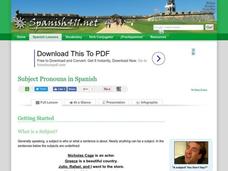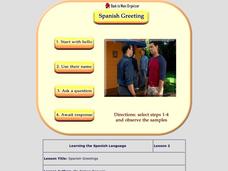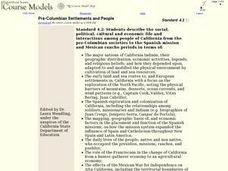Curated OER
Geography of the Study of the Spanish-speaking People of Texas
Students identify the physical features, demographic characteristics, and history of the four Texas towns featured in Russell Lee's photo essay, "The Spanish-Speaking People of Texas." They conduct Internet research, and create a travel...
Curated OER
Describing People
With a variety of pictures, fourth grade Spanish language learners will review adjectives by describing the appearance of the people in the pictures. You will need to bring in the pictures, and consider creating a word bank of adjectives...
Curated OER
Subject Pronouns in Spanish
Starting off with examples and explanations of English subjects and pronouns, this resource explores Spanish subject pronouns in great detail. Each subject pronoun is described and paired with examples. Additionally, the material...
Student Handouts
Working with Primary Sources: The Spanish-American War
Examine the introduction to Our Islands in Their People, written by Major-General Joseph Wheeler. The excerpt, which is about two-and-a-half pages long, is included here along with six questions about the text. Pupils can learn about the...
Rocklin Unified School District
Spanish Speaking Countries Project
Ask your class members to provide a tour of a Spanish speaking country with a brochure and flag project. Learners research their assigned country, making sure to check off each of the required pieces of information listed on the first...
Curated OER
The Study of the Spanish-Speaking People of Texas
Students analyze photographs from an historical perspective. They examine photos on the Study of Spanish-Speaking People of Texas website, complete a worksheet, and write an essay.
Curated OER
Developing Students' Vocabulary Range for Describing People
Students develop vocabulary for describing people.
Curated OER
Spanish Punctuation & Capitalization
Grammar rules in all languages, but that doesn't mean it's the same from English to Spanish. This informational webpage describes the similarities and differences between English and Spanish for the following: periods, commas, question...
Curated OER
Singular Adjectives Worksheet 3- Mi novio es/ Mi novio no es
Who is your boyfriend or girlfriend? Have each learner choose a friend to describe with the use of adjectives. Basic information includes where he or she is from, the high school they attend, and basic traits they do or don't have....
Curated OER
Adjectives and Nouns
Give your class this bell-ringer to review adjectives and nouns when describing people and places. The short paragraph contains 10 blanks, and your learners have to make sure the adjective they use to complete the sentence agrees with...
Curated OER
Lesson 2- Spanish Greeting
Break down a quick conversation in Spanish. After the teacher presents the vocabulary, the class heads to the computer lab, where class members can watch a brief interactive video. The visual is one clip separated into four clearly...
Curated OER
Pre-Columbian Settlements and People
Fourth graders describe the social, political, cultural and economic life and interactions among the people of California from the pre-Columbian societies to the Spanish mission and Mexican rancho periods.
University of California
Impact of the California Missions on Native Americans
While the Spanish claimed to bring civilization to California indigenous peoples, in reality, they also brought violence and forced assimilation to European values. Primary sources, such as the reports of Catholic priests and Europeans...
Curated OER
The Colonization of the United States
Bring the Age of Exploration into the 21st century with this ancestry activity! Learners get a chance to explore the complex genealogy of the Spanish settlers through watching two video clips (approximately five minutes each) featuring...
Curated OER
The Imperfect Tense
Take a trip to the computer lab or flip your class and use this online resource. Spanish language learners can read the included information about the imperfect and practice with the online interactive exercises that are linked on the...
Curated OER
Body Parts in Spanish
Students use Spanish to recognize and recall body parts. In this Spanish anatomy lesson, students identify and name the parts of the body in Spanish. Students describe a person physically by his hair and color of eyes. Students graph...
Curated OER
Spanish Colonials Encounter Quechan Culture
Pupils use primary sources from the de Anza expedition of the 1770's to research colonial encounters with the Quechan people from Yuma Crossing, Arizona.
Curated OER
A Dollar Goes A Long Way
Investigate life along the Old Spanish Trail! They visit websites and identify the history and environment. They create journals, dramatic enactments, and maps to discover the role individuals played in society. They also explore the...
Curated OER
Descriptions with The Very Hungry Caterpillar
Explore famous artists of the Spanish-speaking world to practice describing things. The kids will identify the color each picture uses, whether figures are large or small, what the people look like, etc. Then, read The Very Hungry...
Curated OER
Review of Adjectives
The easiest way to learn how to use adjectives is through practice, practice, practice! Print out pictures of people and various objects, and have pairs attempt to describe the items together. This plan suggests providing laminated index...
Curated OER
¿Qué tienes que hacer hoy?
What does your dad have to do today? What about your cousin? Using the example phrases listed (there are 13), intermediate Spanish language learners write five sentences describing what different people in their family must do today....
Curated OER
The Present Subjunctive: When?
Some Spanish learners believe the subjunctive is frightening. Help eradicate that fear by going into depth on when to use the present subjunctive. There are many different situations in which the subjunctive is used described here. You...
Curated OER
Elementary Spanish: Family
Students explore the Spanish words for family members. They identify family members in Spanish and say the words for where people live. Students explore how say where people are from and they describe a family member in a poem.
Curated OER
Cities and Countries Around the World
Briefly introduce your young Spanish speakers to different cities around the world. Identify the country they are located in, what the people are called from those countries, and the country's location on a class map. Make sure to use...

























